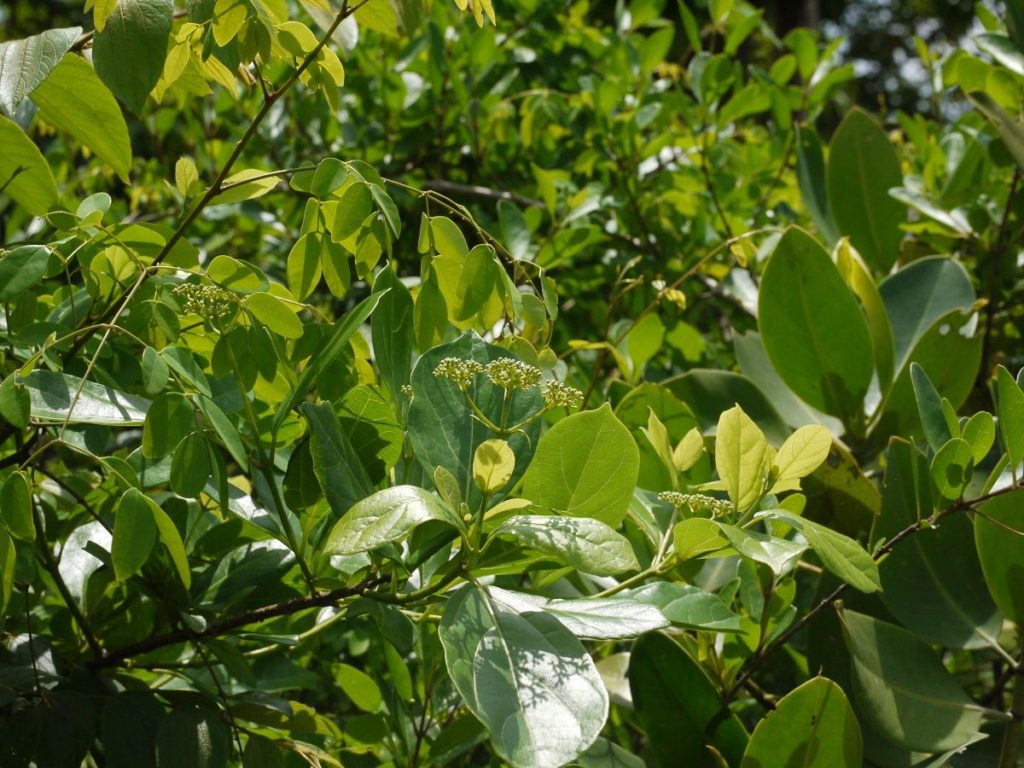
Agnimantha / Clerodendrum phlomidis
- July 28, 2020
- Posted by Dr. Vaidya Karanvir Singh
- 0 Comment(s)
Latin Name- Premna Integrifolia
Plant Family- Verbenaceae
Genus- Premna
Its distribution is in various parts of India like Bengal, Bihar, Madhya Pradesh, etc.
Botanical Synonyms of Agnimantha are Premna Serratifolia, Premna Mucronata, Premna Obtusifolia, and Premna corymbosa
Agnimantha is a medicinal plant that grows either as a large shrub or a small tree. Its height is up to 10 meters tall. Its bark, roots, and leaves are used for medicinal purposes. In Agnimantha, ‘agni’ means fire, ‘mantha’ refers to churning. In the English language, Agnimantha is referred to as a headache tree.
As per Ayurveda, agnimantha is an important ingredient of Dashmool Plants. Dashmool has two subcategories Brihat Panchamoola and Laghu Panchamoola and in these subcategories, Agnimantha is included under Brihat Panchamoola. As per Ayurveda, Agnimantha is useful in treating all types of Vata Disorders (that related to the nervous and musculoskeletal system), inflammatory disorders, neuralgia, rheumatoid arthritis, anemia, piles, constipation, common cold, and loss of appetite, etc.
Names in different languages:
Common Name: Agnimantha (BRIHAD AGNIMANTHA), Headache Tree
English Name: Headache tree
Hindi Name: Agathu, Tekar, Arni, Ganiyari, Agethu
Sanskrit Name: Agnimantha, Shreeparn, Vatghani
Tamil Name: Pachumullai, Taludalai
Marathi Name: Airana, Eran, Takalu, Eirani, Takalu, Chamari
Gujarathi Name: Airanamula, Arani, Aranel
Bengali Name: Ganiyari, Ganibhari, Ganira
Oriya Name: Ganiyari
Malayalam Name: Munnai, Munja
Telgu Name: Gabbunelli, Nelli, Gabbunulli
French Name: Arbe a la migraine
Its Sanskrit synonyms:
Tarkari, Arani, Arani, Sriparna, Vataghhi, Jaya, Ganakarika, and Tarkari
The sticks of this plant are used to produce fire so it is called Agnimantha.
Its leaves are very beautiful so it is called as Sreeparni
It is cultivated in the banks of the river so it is called as Nadeyi or Nadeeja
Due to its good qualities, it brings a good opinion among the people so it is called as Tarakari
Because of its smell, it is called as Patragandhi
Parts used:
- Roots
- Leaves
- Bark
Generally, Agnimantha roots and its bark is used in the treatment of Vata Disorders. Its leaves are useful in treating fevers and infections.
What are the Ayurvedic properties of Agnimantha?
Rasa (Taste)- madhura (Sweet), katu (Pungent), kasaya (Astringent), and tikta (Bitter)
Guna (Quality)- Ruksha (Dry), and Laghu (Light)
Virya (Potency)- Ushna (Hot)
Vipaka (Resultant)- katu (Pungent)
Dosha karma (Effect on dosha)- Pacifies Vata and Kapha dosha
Therapeutic Indications of Agnimantha:
Agnimantha helps in treating the following health conditions.
- Vata related disorders (diseases related to nervous and musculoskeletal system)
- Inflammatory disorders
- Rheumatoid arthritis
- Anemia
- Hemorrhoids or piles
- Common cold
- Neuralgia
- Constipation
- Loss of appetite
- Various fevers – scarlet fever (scarlatina), measles, smallpox, varioloid eruptions, and erysipelas
- Diabetes mellitus
- Dyslipidemia
- Glycosuria
- Chyluria
- Lymphadenitis
- Couth
- Breathing Difficulties and asthma
- Common cold
What are the therapeutic uses of Agnimantha?
Loss of Appetite and malabsorption
Roots of agnimantha have the property of appetizer and digestive. It boosts the appetite and aids in the proper digestion of food. It can digest foods, treats heaviness in the abdomen, drowsy, or tiredness after having a meal. It reduces all the symptoms related to digestion and promotes proper assimilation of the food.
Hemorrhoids or Piles
The decoction of agnimantha is used in a sitz bath instead of simply for relieving pain occurring in hemorrhoids.
Obesity
Agnimantha leaves boost up the metabolism of the body. These have anti-obesity effects and the juice extracted from its fresh leaves is very helpful for reducing weight and improves the metabolism of the fats and prevents fat accumulation. These should be taken twice daily for at least 3 months for better results.
Urticaria
Roots of agnimantha are especially used in the treatment of urticaria because it has anti-allergic, anti-urticaria action, which helps to reduce prickling pain, hives, and itching.
Loss of Appetite & Malabsorption
Agnimantha roots act as appetizer and digestive. It improves appetite and aids in proper digestion. It is the best natural ayurvedic herb for people feeling the inability to digest foods, heaviness in the abdomen, drowsiness, or tiredness after having a meal. It reduces all these symptoms and promotes proper assimilation of the food.
Lymphadenitis
Agnimantha is a very useful herb in alleviating the pain, inflammation, and swelling of the lymph nodes and other symptoms associated with lymphadenitis. Being an anti-inflammatory, antibacterial and antiviral action helps to inhibit the growth of microbes, fights against infections, and reduces inflammation.

Dr. Vaidya Karanvir Singh is the younger Vaidya in Chandigarh Ayurved & Panchakarma Centre. He is the fourth generation in his family who is practicing as a general consultant in Ayurved & Panchakarma treatment at Chandigarh. In his practice, he had treated more than 1 Lakh Plus patients worldwide.

